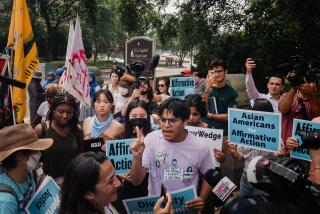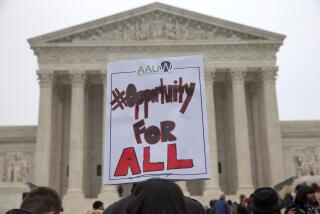THIRD WORLD PERSPECTIVE : ‘Affirmative Action’ Gone Awry : Sri Lanka’s Sinhalese majority, chafing under the Tamil elite, has taken its share and more, wrecking the country.
- Share via
The assassination of President Ranasinghe Premadasa at the hands of a suicide bomber in Sri Lanka on May 1 only deepens the impression of a country in the grip of Third World politics gone mad. But to dismiss it as only that ignores the vital lessons that Sri Lanka’s 10 years of hideous ethnic violence can teach Western societies. The process of fragmentation there has historical roots in many of the same issues here that are starting to vex us along racial and ethnic lines, which should give us pause.
Independence from Britain in 1948 left Ceylon (renamed Sri Lanka in 1972) with seemingly strong political institutions and a promising industrial infrastructure, but it also left cultural and social wounds. These wounds were particularly deep in the Sinhalese Buddhist community, 75% of the population. Many Sinhalese nursed a “majority minority complex,” feel politically inferior to a tiny, yet powerful Westernized elite. The 18% Tamil minority enjoyed, person for person, greater economic success and status than the Sinhalese.
In 1956, Buddhist nationalists were swept into power on promises to restore “the just and proper order” of Sinhalese superiority. Sinhalese nationalism did rectify some of the disfiguring legacies of colonialism. But it also encouraged ethnic divisiveness and ruined the country’s intellectual life and its economy.
Sinhala replaced English as the official language, and Sinhalese benefited from numerous preferential policies. Quotas were implemented in the civil service, allocating jobs to members of each ethnic community based on strict proportionalism, which gave the Sinhalese the lion’s share. The government also nationalized much of the private sector, including the tea, rubber and coconut industries, and created large, inefficiently run state corporations to manage them; many of these basically became Sinhalese hiring halls.
In the schools, only Sinhalese students were given instruction in Sinhala, which limited prospects for Tamil and English speakers. This divisive language policy also left Sinhalese and Tamils without a common tongue to address issues that stood between them, or to build a common national identity. English was dropped as a graduation requirement. In addition, Sinhalese nationalists revamped the teaching of Ceylonese history, turning it into a tool to restore Sinhalese self-esteem.
In the universities, where Sinhala students were underrepresented, another quota system was instituted that admitted Sinhalese students over more qualified Tamils. At the time, some intellectuals warned about lowering standards and the abandonment of “merit.” Nationalists silenced them with arguments that standards were synonymous with the privileges enjoyed by the old elite.
Sinhalese nationalism and cultural primacy created an atmosphere on university campuses that was hostile to the cosmopolitan ethos that had once nourished an erudite, non-sectarian elite. The old Western course of study may have been foreign, but it did foster liberal ideals of tolerance and secular pluralism, which were not to be found in a curriculum shaped by insular indigenous traditions and racial demagoguery.
In addition to shutting Tamils out of higher education, affirmative action on behalf of the majority cut off lower-middle-class Tamils from their only other avenue for upward mobility: government jobs. Before 1956, the civil service was 30% Tamil; it is now around 5%. That created a generation of disaffected Tamil youth, grist for the Tamil Tiger militants who have been fighting since 1983 for an independent homeland--Tamil Eelam--in north and east Sri Lanka. The 10-year struggle has taken an estimated 60,000 lives in a population of 18 million and has created nearly 1 million refugees.
Statist economics and preferential policies may have given the Sinhalese a more equitable slice of the economic pie, but the economy as a whole suffered. At one time, two-thirds of the dozens of public corporations, created in large part to ensure the Sinhalese a hefty share of the economy, needed state subsidies to survive. In the early 1970s, inexperienced Sinhalese managers presided over the deterioration of tea estates, while experienced Tamil managers were driven by employment discrimination to competitors in Indonesia and Kenya. Additionally, while students were taught all about their traditional Sinhalese identity, they were not equipped with the hard skills needed for a developing economy. Sri Lanka, heavily dependent on foreign aid, became a basket case, with some of the worst economic indicators in the Third World.
Of course, Sri Lanka is a country with its own discrete historical experience. But many of the policies that fragmented Sri Lanka are the same ones that have become explosive in other multiethnic societies, including our own. These include racial preference in the workplace and higher education, linguistic separatism, historical revisionism in pursuit of ethnic self-esteem, and a raft of other measures shaped by romantic notions of distinct cultural identities often based on dubious scholarship and demagoguery.
While it is unlikely that these issues will spur outright communal violence here, they do have the capacity to polarize our politics, undermine economic productivity, weaken our educational institutions and strain the bonds that tie us together as a nation and as a people. Sri Lanka’s nightmare should be a warning that identity politics can be extraordinarily divisive for any society. It should also tell us that in rectifying historical and cultural wrongs, we should not weaken the pillars of our common citizenship and culture.
More to Read
Sign up for Essential California
The most important California stories and recommendations in your inbox every morning.
You may occasionally receive promotional content from the Los Angeles Times.












